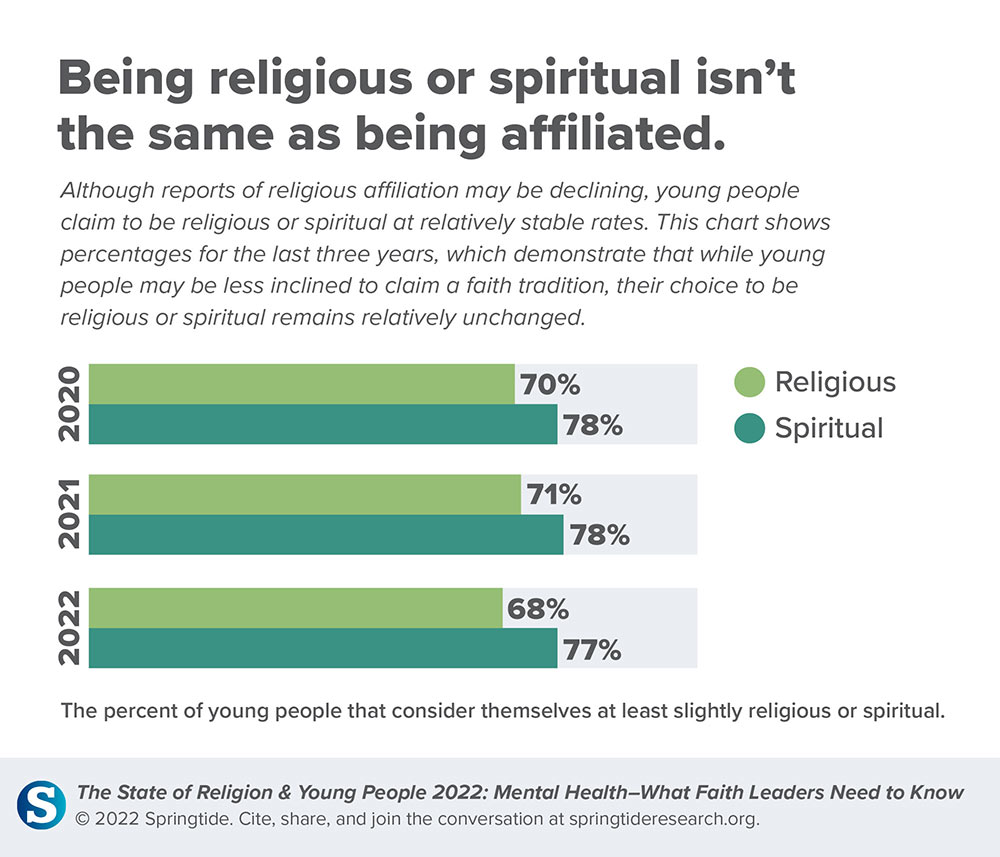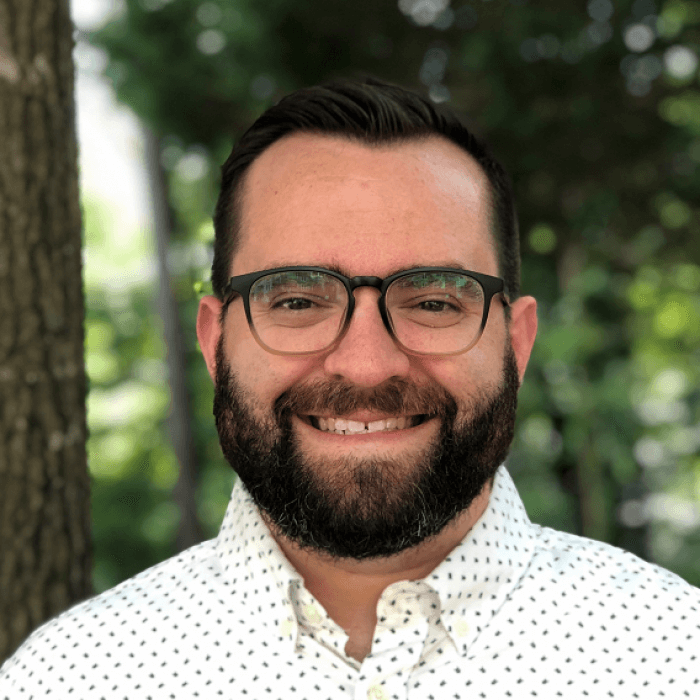Forget the doom and gloom — the future is open for Gen Z and religion

Traditional measurements don’t capture the whole story of young adults and faith. The reality is much more hopeful, say researchers at Springtide Research Institute.
There’s more to the story about religion in America than what polls and surveys indicate — especially among young people.
Consider two recent statements made by one of America’s most prolific religious demographers, Daniel Cox. On the one hand, in a report examining Gen Z’s religious attendance and affiliation trends, he wrote: “In terms of identity, Generation Z is the least religious generation yet.”
On the other hand, in a co-written report about faith after the pandemic, this: “Increasingly, religious affiliation may tell us less about the full range of religious and spiritual experiences Americans have and the extent of their theological commitments.”
Our research findings confirm this tension: Gen Z expresses religiosity and spirituality, but in ways that defy traditional polling measures.
In this new reality, faith leaders can accept existing data as evidence of declining demand for religion among young people and just keep trying to get them back in the church building.
But we firmly believe that the decline narrative is not the full story. We think the better option for faith leaders is to transform their approach to young people in a way that recognizes how they actually are engaging with faith and spiritual practices.
At Springtide Research Institute, we are discovering that in reality, a majority of America’s “least religious generation” identifies as religious (68%) or spiritual (77%) — a fact that changed little even as their already low religious attendance dropped off further during the pandemic.
Gen Z expresses religiosity and spirituality, but in ways that defy traditional polling measures.

So what’s going on with young people?
For decades, sociologists and demographers have looked to two primary indicators of religiosity in individuals or society: affirmed beliefs (e.g., “Do you believe in God with no doubts?”) and frequency of attendance at religious services.
A recent article based on these indicators, for example, doubles down on the thesis that the U.S. is undergoing a process of secularization.
But it’s important to look more closely. This same article notes: “Of course, compared to most other wealthy countries, the U.S. is quite religious. Fifty-five percent of Americans, for example, say they pray daily, compared to an average of 22% of Europeans.”
This includes 47% of Gen Zers who pray at least weekly, according to Springtide’s 2022 annual State of Religion & Young People report.
With Gen Z, traditional indicators of affiliation and attendance no longer explain what’s happening. Cox and his co-authors call this the “decoupling of identity and experience.”
There are far too many voices pronouncing God “dead” (or at least dying) for Gen Z without the full range of evidence needed to back up such a claim.
Those indicators cannot tell you, for example, that numerous young people engage with crystals and herbs, anime, activism and politics, tarot, and nature as spiritual exercises.
Before dismissing these practices as New Age frivolities, consider that young Latter-day Saints and Muslims — groups that traditionally hold more conservative/orthodox religious beliefs — were among the most likely to engage with tarot or other forms of divination on a regular basis (38% and 35%, respectively).
Gen Zers engage in these practices even as they tag along with mainstream religious traditions. We also know that young people who engage in practices like these reap some of the benefits that accompany traditional religious behaviors and expressions.
For example, while 17% of all young people say they are flourishing in their faith, this number increases for young people who engage spiritually with crystals and herbs weekly or daily.
Similarly, while 24% of all young people say they’re flourishing in their mental and emotional health, this number increases for young people who engage with crystals or herbs weekly.
We’re not arguing that Christian churches should replace liturgy with crystals. But a deeper understanding of young adults’ faith and practices can help churches connect with them.
Some faith communities have picked up on Gen Z’s unconventional spiritual quest, dumping traditional programs in favor of eclectic, peer-driven activities that promote what Gen Z says it lacks most: a sense of belonging.
One example is Table Bread, a ministry of The Table United Methodist Church in Sacramento, California. The church discovered that the baking and breaking of bread created community for young people that helped alleviate their isolation and loneliness. As they form authentic relationships around baking bread, the participants have rich and honest conversations centered on Wesleyan concepts and questions.
The project eventually evolved into a youth-led social enterprise that is forming an intergenerational community through farming and bread making. Yet a young person’s participation in these initiatives might not register under traditional survey measures of religious identity and attendance.
And take a look at what happened in February 2023 at Asbury University, where a garden-variety chapel service ignited a two-week, continuous revival, drawing nearly 50,000 students and visitors from around the country. It also sparked similar events on other campuses.
Daniel Darling, a bestselling Christian author and pastor, wrote in response to the Asbury revival:
“I’m bullish on Gen Z. God is doing something. I’ve seen it on our own campus. I’ve seen it on campuses where I’ve preached. We need wisdom and discernment, but I don’t want to be the cranky old guy who obsesses over trend lines, nitpicks away and misses a movement of the Spirit.”
To be sure, the revival has its skeptics. However, whether one is a doubter or a believer in the Asbury revival, the event at least suggests that maybe the experts don’t have the full story on where young Americans are headed with religion. In fact, one could argue that we simply cannot know for sure right now.
Returning to the findings of researcher Daniel Cox: “What most distinguishes Generation Z from previous generations is not that Gen Zers are more likely to leave their childhood religion, but rather that many of them lacked a religious upbringing.”
Cox notes that 15% of Gen Zers report being raised in nonreligious households, more than twice the rate of Gen Xers (6%) and five times the rate of baby boomers (3%).
Many of them say they don’t know how to connect to communities of faith. Almost 40% of young people in Springtide’s 2021 annual State of Religion & Young People report agreed with the statement, “I would not even think to go to a faith community because it is not something I’ve ever gone to before.”
More than half said, “I’m not sure how to get connected to a new faith community.”
The decline of institutional trust, the increase in demographic diversity and the rise of social media, among other factors, mean that young people are operating in a different social environment than the one that gave rise to the successful program-driven models of youth engagement over the past 50 years.
What can faith leaders do in place of programs? They can invest in building trust through authentic relationships with young people rather than relying on institutional authority to do the lifting. They can promote belonging to the same degree as believing. They can address the issues that young people care about, like racial and ethnic identity and mental health. They can bake and break bread.
At Springtide, we know that there are more examples of innovative approaches to engaging young people, because young people tell us about them all the time.
With a new grant from Lilly Endowment Inc., we are excited to spend the next three years identifying the who and the what behind those approaches and why they are so successful with young people, with the goal of developing frameworks that can be adapted and applied in faith communities everywhere.
We are excited to tell a new story — perhaps even the true story — about the spiritual potential of young Americans. Among the epitaphs written about young people and the church, we hope to announce new births — and to normalize a posture of hope and anticipation for the exciting places young people will take religion in the years to come.




Share